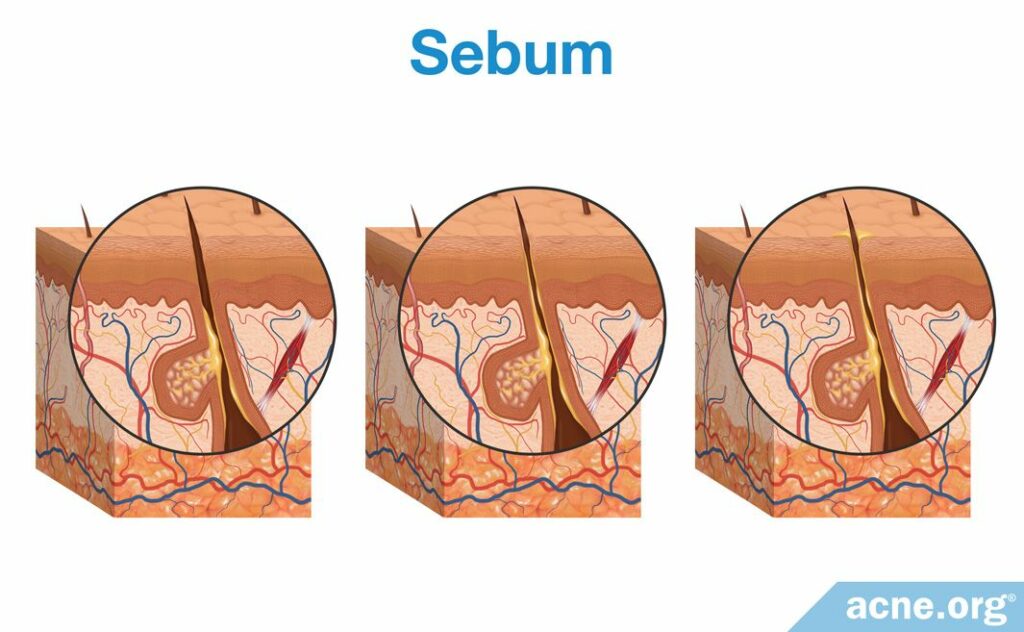Generally Speaking, More Sebum = More Acne. Also, When the Composition of Sebum Goes Awry, That May Also Lead to Acne.

The Essential Info
What Sebum Is: Sebum is the medical name for skin oil. It is produced by glands that are attached to skin pores all over the body. These glands are particularly large on the face and upper body, where acne normally forms. Acne cannot form without sebum.
How Sebum Contributes to Acne: Excess sebum production may lead to an overgrowth of skin cells, which clogs pores. Once a pore becomes clogged, sebum gets trapped inside, providing a breeding ground for acne bacteria.
More Sebum = More Acne: Generally speaking, the more sebum you have, the more likely you are to have acne. Research shows us that increases in male hormones that are present in both males and females lead to an overproduction of sebum.
Composition of Sebum May Also Matter: It may not be just overproduction of sebum that leads to acne. The fats that make up sebum can vary from person to person, and some of these fats may lead to more acne than others. Researchers are finding that the composition of sebum may be equally important, or maybe even more important, than the amount of sebum that is produced.

The Science
- More Sebum = More Acne
- Male Hormones Are at Fault
- Altered Sebum Composition May also Be an Important Factor
- Conclusion

A skin pore is basically a tiny hair follicle. Attached to the sides of pores are skin oil glands called sebaceous glands. At puberty, these glands start to produce skin oil, called sebum, that is released into the pore. In healthy skin, sebum is released into the pore, and it then slowly moves up the pore and onto the surface of the skin.1
More Sebum = More Acne
Sebaceous glands are found in the largest numbers on the face and upper body – areas of the skin that are highly prone to acne. People with acne generally have enlarged sebaceous glands and produce more sebum compared to people without acne.2 The research is clear. Generally speaking, more sebum = more acne.
Excess sebum is thought to contribute to acne in 2 main ways:
- Clogging pores: Too much skin oil may lead to pores becoming clogged. Exactly how it does this remains something of a mystery, but it may be that excess sebum stimulates the skin to overproduce skin cells, and this may lead to clogged pores.
- Providing food for bacteria: Once a pore is clogged, acne bacteria feed on the fats in sebum and multiply, leading to red, inflamed acne lesions.
Male Hormones Are at Fault

Scientists think that the driving force behind excess sebum production is androgens, which are male hormones that are present in both males and females. Testosterone is an example of an androgen. Generally speaking, the more androgens in the bloodstream, the more sebum the body produces.
This is why acne is almost never seen during childhood, when androgen levels and sebum production levels are low. At the onset of puberty, androgen levels rise, causing sebaceous glands to grow and produce more sebum, and acne forms.3
As further evidence of the link between androgens and sebum production, castrated men are deficient in androgens, produce less sebum than normal men, and do not develop acne. Castrated men will, however, develop acne if given supplemental testosterone.2,4
Another Culprit: A Hormone Called Insulin-like Growth Factor 1 (IGF-1)
Insulin-like growth factor 1 (IGF-1) is another, less well-known hormone that also plays a role in acne. This hormone regulates growth of the body, particularly during puberty. In addition, IGF-1 increases sebum production in 2 ways:
- Stimulating the sebaceous gland to produce more skin oil
- Triggering the production of more androgens, which in turn leads to more skin oil5
Several studies have found that higher levels of IGF-1 in the blood go hand-in-hand with higher sebum production. Research also shows that patients with acne tend to have increased levels of IGF-1.6
Another corroborating piece of evidence is that patients with Laron syndrome, who have abnormally low IGF-1 levels, do not develop acne.7
Altered Sebum Composition May also Be an Important Factor
Sebum is an oil consisting of several different types of fat molecules.
Emerging evidence is pointing toward the strong possibility that it is not just the amount of sebum someone produces, but the composition of that sebum that may lead to acne. As researchers from a study published in 2014 in the Journal of European Academy of Dermatology and Venereology explain:

“[E]merging data . . . indicate that sebum composition may be more important for the development of acne lesions than the secreted amount.”8
Let’s have a closer look at the fats that make up sebum and how they might contribute to acne.

Free fatty acids
One type of fat molecule found in sebum is called a free fatty acid.9 Scientists have found unusually high levels of fatty acids in clogged pores (comedones), suggesting that an increase in the fatty acid content of sebum may play an important role in pore clogging. Specifically, scientists have shown that fatty acids trigger the body’s production of a specific inflammatory substance called Interleukin-1 (IL-1), which is known to trigger acne.8
Research also shows that it may not just be the total amount of fatty acids in sebum, but the relative amounts of specific types of fatty acids. In other words, if you have an altered fatty acid balance, this may lead to acne.10
Squalene
Another fat molecule in sebum that can also trigger acne is squalene. One small study found that people with acne have more than twice as much squalene in their sebum as people without acne.11 Squalene is a normal part of sebum, but too much squalene may trigger inflammation, causing the body to produce a different inflammatory substance called Interleukin-6 (IL-6). Squalene may also lead to an excessive growth of skin cells, clogging skin pores and leading to acne.8 Lastly, squalene may react with other substances in the skin, producing free radicals, which are harmful molecules that can cause skin damage and trigger inflammation and the formation of acne.10-13
Linoleic acid
We have seen that too many free fatty acids and too much squalene may lead to clogged pores, but on the flip side of the coin, when another component of sebum is reduced, we tend to see more acne. That substance is called linoleic acid. Scientists have found that clogged pores (comedones) contain lower than normal concentrations of linoleic acid.3
Linoleic acid is important for a strong skin barrier. Reduced linoleic acid can weaken the skin and can make the skin pore more susceptible to damage from inflammation, and you guessed it, more acne.
Conclusion
Sebum is necessary for acne formation. Increased sebum production, driven by higher than normal androgen levels, increases the formation of acne.
Sebum composition may also play a big role. More free fatty acids and squalene, and less linoleic acid are thought to potentially initiate and worsen acne.
References
- Danby, F. Ductal hypoxia in acne: Is it the missing link between comedogenesis and inflammation? J. Am. Acad. Dermatol. 70, 948-949 (2014). https://www.ncbi.nlm.nih.gov/pubmed/24742839
- Degitz, K., Placzek, M., Borelli, C. & Plewig, G. Pathophysiology of acne. J. Dtsch. Dermatol. Ges. 5, 316-323 (2007). https://www.ncbi.nlm.nih.gov/pubmed/17376098
- Cunliffe, W et al. Comedone formation: Etiology, clinical presentation, and treatment. Clin. Dermatol. 22, 367-374 (2004). https://www.ncbi.nlm.nih.gov/pubmed/15556720
- Leyden, J. et al. A systemic type i 5 α-reductase inhibitor is ineffective in the treatment of acne vulgaris. Am. Acad. Dermatol. 50, 443-447 (2004). https://www.ncbi.nlm.nih.gov/pubmed/14988688
- Melnik, B. C. & Schmitz, G.. Role of insulin, insulin-like growth factor-1, hyperglycaemic food and milk consumption in the pathogenesis of acne vulgaris. Exp. Dermatol. 18, 833-841 (2009). https://pubmed.ncbi.nlm.nih.gov/19709092/
- Clayton, R. W., Göbel, K., Niessen, C. M., Paus, R., van Steensel, M. A. M. & Lim, X. Homeostasis of the sebaceous gland and mechanisms of acne pathogenesis. Br. J. Dermatol. 181, 677-690 (2019). https://pubmed.ncbi.nlm.nih.gov/31056753/.
- Ben-Amitai, D. & Laron, Z. Effect of insulin-like growth factor-1 deficiency or administration on the occurrence of acne. J. Eur. Acad. Dermatol. Venereol. 25, 950-954 (2011). https://pubmed.ncbi.nlm.nih.gov/21054577/
- Zouboulis, C., Jourdan, E., & Picardo M. Acne is an inflammatory disease and alterations of sebum composition initiate acne lesions. J. Eur. Acad. Dermatol. Venereol. 28, 527-532 (2014). https://www.ncbi.nlm.nih.gov/pubmed/24134468
- Tanghetti, E. The role of inflammation in the pathology of acne. J. Clin. Aesthet. 6, 27-35 (2013). https://www.ncbi.nlm.nih.gov/pmc/articles/PMC3780801/
- Li, X., He, C., Chen, Z., Zhou, C., Gan, Y. & Jia, Y. A review of the role of sebum in the mechanism of acne pathogenesis. J. Cosmet. Dermatol. 16, 168 – 173 (2017). https://www.ncbi.nlm.nih.gov/pubmed/28556292
- Pappas, A., Johnsen, S., Liu, J. C. & Eisinger, M. Sebum analysis of individuals with and without acne. Dermatoendocrinol. 1, 157 – 161 (2009). https://www.ncbi.nlm.nih.gov/pubmed/20436883
- Ottaviani, M., Camera, E. & Picardo, M. Lipid mediators in acne. Mediators Inflamm. 2010, 858176 (2010). https://www.ncbi.nlm.nih.gov/pubmed/20871834
- Youn, S. W. The role of facial sebum secretion in acne pathogenesis: facts and controversies. Clin. Dermatol. 28, 8 – 11 (2010). https://www.ncbi.nlm.nih.gov/pubmed/20082943
 Acne.org Products
Acne.org Products